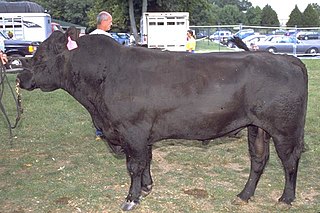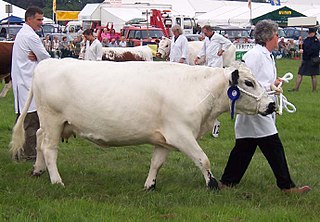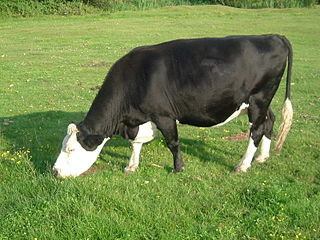
Telemark cattle or Telemark cow is an old Norwegian breed of cow.

Telemark cattle or Telemark cow is an old Norwegian breed of cow.
Telemark cattle are red, with a white colour on the back in the shape of a cross. Sometimes, cows are also white on the underside. The face is usually mixed in colour. Most Telemark colour have horns. The Telemark is primarily a milking breed, and does not grow very large. Animals do not usually weigh more than 500 kilograms (1,100 lb). [1]
Telemark cattle were defined as a breed in 1865. The driving force behind the work was the state agronomist Johan Lindeqvist, originally from Sweden. After the war, Norwegian red cattle were introduced into Norway. Traditional cow breeds then suffered a major drop off in numbers. In the 1980s, there were steps put into place to protect rare breeds. In 2006, there were 400 animals of this breed in Norway. [2]

The Highland is a Scottish breed of rustic beef cattle. It originated in the Scottish Highlands and the Western Islands of Scotland and has long horns and a long shaggy coat. It is a hardy breed, able to withstand the intemperate conditions in the region. The first herd-book dates from 1885; two types – a smaller island type, usually black, and a larger mainland type, usually dun – were registered as a single breed. It is reared primarily for beef, and has been exported to several other countries.

The Jersey is a British breed of small dairy cattle from Jersey, in the British Channel Islands. It is one of three Channel Island cattle breeds, the others being the Alderney – now extinct – and the Guernsey. The milk is high in butterfat and has a characteristic yellowish tinge.

The Aberdeen Angus, sometimes simply Angus, is a Scottish breed of small beef cattle. It derives from cattle native to the counties of Aberdeen, Banff, Kincardine and Angus in north-eastern Scotland. In 2018 the breed accounted for over 17% of the UK beef industry.

The Holstein Friesian is an international breed or group of breeds of dairy cattle. It originated in the Dutch provinces of North Holland and Friesland and in Schleswig-Holstein in northern Germany. It is the dominant breed in industrial dairy farming worldwide, and is found in more than 160 countries. It is known by many names, among them Holstein, Friesian and Black and White.

The Heck or Munich-Berlin is a German breed or type of domestic cattle. It was bred in the 1920s by Heinz and Lutz Heck in an attempt to breed back the extinct aurochs. Controversy revolves around methodology and success of the programme. There are considerable differences between Heck cattle and the aurochs in build, height, and body proportions. Furthermore, there are other cattle breeds which resemble their wild ancestors at least as much as Heck cattle.

The Galloway is a Scottish breed of beef cattle, named after the Galloway region of Scotland, where it originated during the seventeenth century.

A piebald or pied animal is one that has a pattern of unpigmented spots (white) on a pigmented background of hair, feathers or scales. Thus a piebald black and white dog is a black dog with white spots. The animal's skin under the white background is not pigmented.

The Simmental or Swiss Fleckvieh is a Swiss breed of dual-purpose cattle. It is named after the Simmental – the valley of the Simme river – in the Bernese Oberland, in the canton of Bern in Switzerland. It is reddish in colour with white markings, and is raised for both milk and meat.

The Guernsey is a breed of dairy cattle from the island of Guernsey in the Channel Islands. It is fawn or red and white in colour, and is hardy and docile. Its milk is rich in flavour, high in fat and protein, and has a golden-yellow tinge due to its high β-carotene content. The Guernsey is one of three Channel Island cattle breeds, the others being the Alderney – now extinct – and the Jersey.

The Dairy Shorthorn is a British breed of dairy cattle. It derives from the Shorthorn cattle of Tees-side, in the North Riding of Yorkshire and in Northumbria in north-eastern England. The Shorthorn was for this reason at first known as the Durham or Teeswater.

The Belted Galloway is a traditional Scottish breed of beef cattle. It derives from the Galloway cattle of the Galloway region of south-western Scotland, and was established as a separate breed in 1921. It is adapted to living on the poor upland pastures and windswept moorlands of the region. The exact origin of the breed is unclear, although the white belt for which they are named, and which distinguishes the breed from black Galloway cattle, is often surmised to be the result of cross-breeding with the similarly-coloured Dutch Lakenvelder breed.

The British White is a naturally polled British cattle breed, white with black or red points, used mainly for beef. It has a confirmed history dating back to the 17th century.

The Old Gloucester or Gloucester is a traditional British breed of cattle originating in Gloucestershire and surrounding areas in the West Country of England. It was originally a triple-purpose breed, reared for milk, for beef and for draught use; it is now a dual-purpose animal. It is an endangered breed, and its conservation status is listed as "priority" by the Rare Breeds Survival Trust.

The Shetland, known natively in the Scots language as Shetland kye is a small, hardy Scottish breed of cattle from the Shetland Islands to the north of mainland Scotland. The cattle are normally black and white in colour but there are smaller numbers in grey, red and dun.

The Black Hereford is a crossbreed of beef cattle produced in Britain and Ireland with Hereford beef bulls with Angus. Black Herefords are not usually maintained from generation to generation, but are constantly produced as a byproduct of a terminal cross. They are one of the most common types of beef cattle in Britain and Ireland, outnumbering many pure beef breeds.

The Lincoln Red is a British breed of red-coated beef cattle. It originates in, and is named for, the county of Lincolnshire in the eastern Midlands of England. It was selectively bred in the late eighteenth and early nineteenth centuries by crossing large local draught cattle of the region with Teeswater Shorthorns of medium size. It was at first known as the Lincolnshire Red Shorthorn, and was a dual-purpose breed, reared both for milk and for beef. The polling gene was introduced in the early twentieth century, and the cattle are now usually polled; the word 'shorthorn' was dropped from the breed name in 1960. In the twenty-first century it is reared for beef.

Norwegian Red is a breed of dairy cattle developed in Norway since 1935. Since the 1970s, breeders strongly emphasized functional and production traits resulting in excellent production combined with world-leading performance in health and fertility traits. Norwegian Red cows can have either a red and white or black coat and have a high proportion of genetically polled animals.

Dyrsku'n is an annual agricultural show held in Seljord, Norway. It originates from the first exhibition held in 1866. Dyrsku'n was primarily a showcase for the breed Telemark cattle. Today's show has a wider agricultural scope, and attracts about 70–80,000 visitors.

The Swedish Red Polled, Swedish: Rödkulla, is a Swedish breed of domestic cattle. It is a dual-purpose breed, raised both for its milk and for its meat.
The Droimeann cow is an endangered breed of cattle unique to Ireland. It was officially recognised as a rare native breed on 8 January 2020 following DNA profiling which showed that it was genetically distinct from other breeds. Animals may be black, red or roan, but most have a white stripe along the back. In 2020, there were 243 breeding females and 23 breeding males registered.